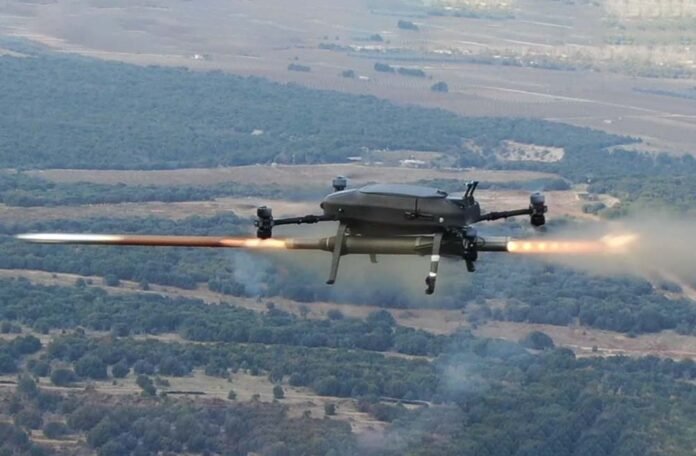SAS Technology, Greece’s leading company in the research and development of armed unmanned systems, has successfully concluded an intensive three-day live-fire testing campaign (February 10–12, 2025). These trials confirmed the advanced operational capabilities of the company’s UCAV, SARISA II (SRS-2A), marking yet another milestone in the evolution of autonomous combat systems.
The tests demonstrated SARISA II’s ability to accurately and reliably fire both unguided
(UGR) and LASER-guided (LGR) 70mm (2.75-inch) rockets from THALES Belgium in
consecutive launches, ensuring precision and exceptional stability.
This campaign represented the final stage of certification for SARISA II, establishing it as the first UCAV platform worldwide to integrate and operationally launch LASER-guided rockets, specifically the FZ275 LGR from THALES—a capability previously exclusive to manned attack helicopters and fighter aircraft. The tests were conducted under the supervision of the Hellenic Ministry of National Defense, in collaboration with THALES Belgium, and with the critical support of Hellenic Defense Systems (HDS), whose technical contribution and assistance was instrumental in the program’s success.
Day 1 (Feb. 10): Unguided Rocket Firing – Stability & Firepower
SARISA II successfully launched a 70mm UGR rocket while maintaining a stable hover,
demonstrating exceptional flight stability despite the strong rocket jet blast. The unguided
rocket’s trajectory remained predictable, allowing for accurate targeting using simple optical sight.

Day 2 (Feb. 11): Laser-Guided Rocket (LGR) Testing – Precision Strikes
SARISA II fired an FZ275 LGR LASER-guided rocket, achieving a deviation of just 0.2m from the designated point of impact on a 5x5m target with a central 2x2m section, confirming its ability for high-precision strategic strikes (CEP <1m).
Due to geographical constraints of the firing range and Weapon Danger Area (WDA)
limitations, the test was conducted at 1,700 meters, close to the weapon’s lower operational range. However, the FZ275 LGR’s ideal operational range is between 3 to 5 kilometers, with a maximum reach of 7 kilometers.

Firing at close range posed unique challenges, as the rocket accelerates to supersonic speeds and deploys its guidance fins after 400 meters, limiting available maneuvering distance. Nevertheless, SARISA II performed as an exceptionally stable launch platform, ensuring precise target engagement even under these demanding conditions. Notably, the flight, positioning, and firing sequence were conducted entirely autonomously, with no manual aiming from the operator. The engagement relied solely on SARISA II’s ability to
autonomously navigate, align, and stabilize at the launch point with remarkable precision.
Day 3 (Feb. 12): Demonstration for Military & International Delegations
The final day featured a high-profile live demonstration, attended by Senior Military
Officials, specialized personnel from all branches of the armed forces (Army, Navy, Air Force, and Special Forces), as well as international delegations expressing interest in the SARISA system.
SARISA II successfully launched a supersonic, LASER-guided FZ275 LGR rocket, weighing 12kg, from an altitude of 450m ASL, showcasing once more exceptional stability and accuracy, proving again the CEP<1m capability.
Additionally, the Hellenic Special Forces demonstrated the UCAV Empusa EMPX6T, the first Greek-designed armed unmanned system in operational service since 2020. EMPUSA carried out precision grenade drop missions, deploying its payload of three grenades in both
sequential and simultaneous release modes. The demonstration began with training grenades and concluded with the release of live defence type grenades, delivering an impressive display.
The day’s program also included the planned release of an AIHMI loitering munition from SARISA II. However, the appearance of low cloud cover prevented the execution of the AIHMI SOLM (AHM-1X) release and flight demonstration.

A New Era in Unmanned Combat Operations
With this major achievement, SARISA II redefines the role of unmanned systems in modern warfare, offering a more efficient and cost-effective alternative to the traditional, high-cost deployment of attack helicopters and fighter aircraft for close air support missions.
SAS Technology extends its gratitude to its partners at THALES Belgium and Hellenic Defense Systems (HDS) for their support and collaboration, as well as the Hellenic Ministry of National Defense, the Hellenic Army, the 24th Armored Brigade, and the Litochoro Firing Range, for their crucial contributions to the success of this program.
















